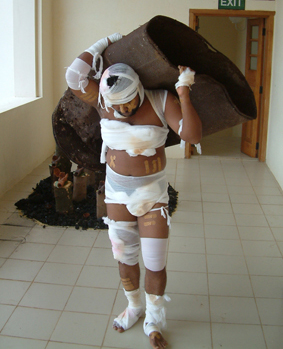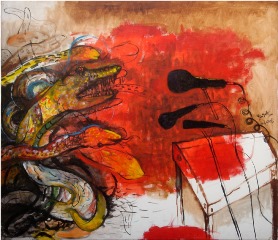Visual Arts, Society and Politics in Sri Lanka
Sasanka Perera (Sri Lanka)
Professor, South Asian University / ALFP 2010 Fellow
As seen in my recent work, I am confident that visual arts (by which I mean painting, sculpture, installation and performance art), if they have taken as their point of departure a sense of politics, can be seen as a repository of memory and commentary on evolving societal conditions and transformations.1 This is the kind of work that might be loosely called “political art.” But in so far as most conventional assessments of art are concerned, the relationship between art and politics is not always clear. For instance, simply because socio-political instability might be a fact of life in a particular country at a specific time, this in itself does not necessarily mean that politically expressive art will be generated from that context. Due to the lack of personal safety such conditions might usher in, art that comes out of such conditions might self-consciously become politically noncommittal or aesthetically sedate. It is this kind of situation that Landauer refers to when she notes that periods of cultural and political upheaval do not intrinsically produce art “affectively addressing that ferment.”2 The relative lack of political engagement within avant-garde art circles in New York in the 1960s, despite considerable political crises impacting not merely the United States, but the world in general at the time, typifies this possibility.3 Susan Sontag described the New York avant-garde’s nonengagement with the Vietnam War as an “aesthetic of silence.”4
But this is not the only possibility between art and politics. For instance, Pablo Picasso’s rather obvious critique of war, violence and fascism embedded in his well-known work Guernica and George Grosz’s satirical sense of visuality are merely two of many examples of artists who engaged with the politics surrounding them through their work. In general, however, many artists do not wish to engage with politics in their work due to the risk of such politically engaged work being labeled banal or naïve.5
It is in this context that I would briefly read post-1990s art in Sri Lanka as a form of self-conscious politics. The specific genre of art I have in mind is called the “Art of the 1990s” or the “’90s Trend” which very deliberately opted to deal with the evolving politics in the country that varied from issues of war, violence and nationalism at one level of expression to matters of self-identity, relationships among the genders and issues of urbanism on yet another level of expression. As Weerasinghe has noted, many of the artists who represented this trend emerged as a “group of people living with memories of violence, dispossession and despair, on the one hand, and on the other, as the casualties of the alluringly strange beauty and the evasive nature of urban culture.”6 Generally, some of the artworks produced by these artists tended to reorganize situations of chaos into a seeming sense of order, while others presented “perplexity as a rational consciousness.” 7 Others presented situations of chaos and perplexity in a surreal and mythic visual language. 8

International Artists Collective Archives, Colombo.
In this context, the series paintings and installations by Chandraguptha Thenuwara under the general theme “Barrelism,” containing images of camouflage-painted barrels as a well-established sign of war, invited viewers to ponder over Sri Lanka’s civil war and the human destruction it brought along with it. Pala Puthupitiye’s series of works, focused on soldiers who acquired heroic status in Sinhala society during the war, asked viewers to explore how the war itself negatively impacted soldiers through death and debilitating injury, while Bandu Manamperi’s performance work often referred to ideas of violence (see Figure 1).
A considerable body of Jagath Weerainghe’s work also dealt with issues of organized political violence and the complicity of institutionalized religion and formal mass media in this violence (see Figure 2).

Theertha International Artists Collective Archives,
Colombo.
Many such artists did not see their work as a simple matter of transforming their memories and experiences into aesthetic commodities that had a market value. However, some of these works sold well, particularly among members of the Colombo-based expatriate community, while a number of museums in Japan and Western Europe also acquired such works. Due to the negative cultural value linked to themes such as death and violence in Sri Lankan culture, which most of these works dealt with, there were very few local patrons for these works. But as a collective discourse, these works ensured that certain kinds of discussion on the issues they dealt with took place in public. In other words, they became a consistent repository of Sri Lankan politics of violence and nationalism in very overt ways.
Today, Sri Lanka’s political history of the recent past will be incomplete if the histories narrated by these kinds of artworks are not taken into account. That is, political art in the Sri Lanka context needs to be seen as a methodology of accessing socio-political information that would enhance our understanding of local history and politics. In this sense, political art in Sri Lanka goes beyond mere aesthetics, and enters the more difficult and contested terrain of political and historical interpretation.
The contents of this article reflect solely the opinions of the author.



